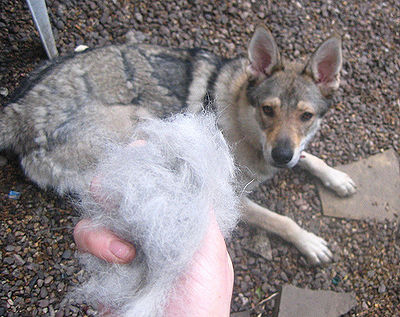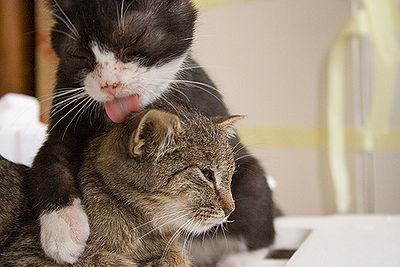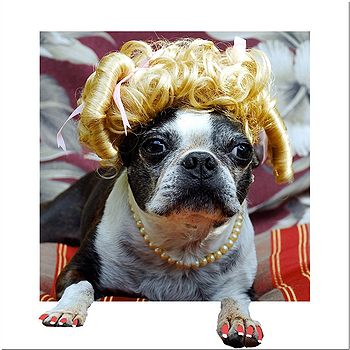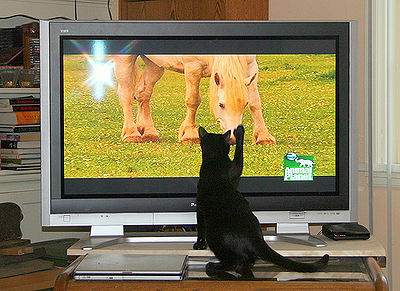 |
All animals shed to a degree. The amount of shedding and regrowth of hair varies with age, breed, environment and health. Dogs normally shed twice a year, in spring and fall. Shedding is a normal process that rids the coat of dead hair. Shedding in the spring allows the dog to rid itself of its heavy winter coat. Fall shedding prepares the dog’s coat for new growth for winter warmth. Today, with houses being heated and most dogs living indoors, shedding can be a year round problem.
Good grooming practices are essential to help in the control of shedding. Brushing your dog often, once or twice daily for heavy coats, will help rid fur of much of the loose hairs and dirt. Unless your dog is extremely dirty, it’s best not to bathe too often as it can remove oils and cause dry skin.
There is help to decrease the amount of shedding and to aid in cleanup around the house.
Discuss your dog’s diet with your vet. Your vet may recommend supplements such as Omega 3 oils to help in controlling shedding and keeping the coat soft and shiny. Omega 3 oils also work well for any skin problems.
Use only gentle shampoos made specifically for dogs when bathing. Human shampoos are not recommended and can irritate a dog’s sensitive skin.
There are many different types of brushes, combs and special gloves for hair removal. Select one or two that are suitable for your dog’s coat. Cover your furniture with washable materials, your car too. Keep dog beds clean with regular laundering.
The Furminator is a tool that easily rids the dog of loose hair. Some newer products include pet hair magnets and Bissell’s Pet Hair Broom. Bissell also makes vacuum attachments and a hand-held pet hair vacuum. There are special shampoos that are supposed to control shedding and a rubber massage curry brush.
All dogs shed, but some shed more than others and some shed so little, it’s barely noticeable.
Here is a partial list of some dogs that shed a lot.
- German Shepherds (I have one and can attest to that)
- Labrador Retrievers
- Golden Retrievers
- Collies
- Shetland Sheepdogs
- Rottweilers
- Dalmatians
Short-haired dogs hair seems to be more difficult to remove.
Some dogs that shed little or seem not to shed at all are:
These lists just name a few. Most wire-haired dogs shed little.
If your dog sheds excessively or has bald patches, these could be signs of an underlying illness. It’s time for a trip to the vet and a checkup.
Cats’ shedding, while perfectly normal, is a nuisnace for your cat and for you. Cats that live outdoors usually shed twice a year. But indoor cats, as with dogs, artificial heat and cooling leaves them shedding all year.
The proper diet will help keep your cat’s coat shiny and soft. It is important to feed your cat a high quality food to maintain a healthy coat. The addition of Omega 3 oils along with vitamins and minerals adds to your cat’s well-being.
There are tools available to help you keep your cat’s coat looking its best. Your supplier will have tools to remove mats and tangles from your long-haired cat. You can find a variety of brushes and combs for your cat’s particular type of coat. A spray conditioner can make brushing easier. Bathing your cat regularly helps to keep it sweet-smelling and removes loose hair. However, if your cat really dislikes water, there are bath wipes and sprays you can use instead.
The same cover and/or throws you use for your dog will work for cat hair. Be sure the material you use can be easily laundered.
You can keep sticky rollers on hand for the extra jobs to pick up loose hair. And the same vacuum attachments for dog hair will work for cat hair.
When cats lick their fur, they ingest small amounts which eventually become “hair balls.” Most cats usually manage to vomit them out. So it’s very important for the health of your cat to control shedding.
The Cornish Rex, the Devon Rex and the Sphynx are breeds of cat that shed very little.
If your cat suffers excessively from hair balls or shedding or has bald spots, consult your vet as this may be an indication of illness.



